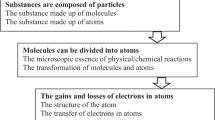Abstract
Spatial understanding of molecules in molecular biology provides a better understanding of molecules in isolation and relation to their next elements. Augmented reality (AR) has recently been developed as a computer interface that enables the users to see the real world with virtual objects superimposed on it. We report a method that shows the use of AR and data provided from protein data bank (PDB) to facilitate the teaching of macromolecules in biology. Users can easily convert the molecules structures obtained from PDB to a 3D format and use it with an AR application to study the molecules from different perspectives. A sample of 60 college students was assigned randomly to one of two conditions namely 2D and AR. At the end of the experiment, participants completed a comprehensive test and then a satisfaction questionnaire. The results of the study showed a significant difference between 2D and AR in satisfaction, the media usability, perception, and apprehension.

Similar content being viewed by others
References
Azuma, R. T. (1997). A survey of augmented reality. Presence, 6(4), 355–385.
Bandura, A. (1977). Self-efficacy: toward a unifying theory of behavioral change. Psychological Review, 84(2), 191.
Bandura, A. (1986). Social foundations of thought and action. Englewood Cliffs: Prentice Hall.
Cheng, K. H., & Tsai, C. C. (2016). The interaction of child–parent shared reading with an augmented reality (AR) picture book and parents' conceptions of AR learning. British Journal of Educational Technology, 47(1), 203–222.
Dawley, L., & Dede, C. (2014). Situated learning in virtual worlds and immersive simulations. In Handbook of research on educational communications and technology (pp. 723–734). New York: Springer.
Dede, C. (2008). Theoretical perspectives influencing the use of information technology in teaching and learning. In International handbook of information technology in primary and secondary education (pp. 43–62). Springer. Retrieved from http://link.springer.com/chapter/10.1007/978-0-387-73315-9_3
Dunleavy, M. (2014). Design principles for augmented reality learning. TechTrends, 58(1), 28–34.
Dunleavy, M., & Dede, C. (2014). Augmented reality teaching and learning. In Handbook of research on educational communications and technology (pp. 735–745). New York: Springer.
Gallagher, A. G., & O’Sullivan, G. C. (2011). Fundamentals of surgical simulation–principles and practices. Retrieved from http://archpsyc.jamanetwork.com/data/Journals/JAMA/22492/jbk0307_974_975.pdf
Galton, F. (1883). Inquiries into the human faculty & its development. JM Dent and Company. Retrieved from https://books.google.com/books?hl=en&lr=&id=V91CAQAAMAAJ&oi=fnd&pg=PA1&dq=Galton,+1883&ots=crKYQGAe1A&sig=hduPNx4tK2kAXnV2oMwOIeZlCiA
Ganley, C. M., Vasilyeva, M., & Dulaney, A. (2014). Spatial ability mediates the gender difference in middle school students' science performance. Child Development, 85(4), 1419–1432.
Gillet, A., Sanner, M., Stoffler, D., & Olson, A. (2005). Tangible interfaces for structural molecular biology. Structure, 13(3), 483–491.
Guilford, J. P., & Lacey, J. I. (1947). Printed classification tests. DTIC Document. Retrieved from http://oai.dtic.mil/oai/oai?verb=getRecord&metadataPrefix=html&identifier=AD0651781
Holopainen, J., Mattila, O., Parvinen, P., Pöyry, E., & Seppälä, K. (2018). Employing mixed reality applications: Customer experience perspective. In Proceedings of the 51st Hawaii International Conference on System Sciences.
Kosslyn, S. M., Ganis, G., & Thompson, W. L. (2006). Mental imagery and the human brain. Progress in Psychological Science around the World, 1, 195–209.
Malone, T. W. (1981). Toward a theory of intrinsically motivating instruction*. Cognitive Science, 5(4), 333–369.
Martín-Gutiérrez, J., Saorín, J. L., Contero, M., Alcañiz, M., Pérez-López, D. C., & Ortega, M. (2010). Design and validation of an augmented book for spatial abilities development in engineering students. Computers & Graphics, 34(1), 77–91.
North, M. M., & North, S. M. (2016). A comparative study of sense of presence of traditional virtual reality and immersive environments. Australasian Journal of Information Systems, 20. https://doi.org/10.3127/ajis.v20i0.1168.
Palincsar, A. S. (2005). 12 Social constructivist perspectives on teaching and learning. In An Introduction to Vygotsky (Vol. 285).
Rodic, M., Zhou, X., Tikhomirova, T., Wei, W., Malykh, S., Ismatulina, V., ... & Kovas, Y. (2015). Cross-cultural investigation into cognitive underpinnings of individual differences in early arithmetic. Developmental Science, 18(1), 165–174.
Salancik, G. R., & Pfeffer, J. (1978). A social information processing approach to job attitudes and task design. Administrative Science Quarterly, 23, 224–253.
Stieff, M., & Uttal, D. (2015). How much can spatial training improve STEM achievement? Educational Psychology Review, 27(4), 607–615.
Teo, T., & Zhou, M. (2014). Explaining the intention to use technology among university students: a structural equation modeling approach. Journal of Computing in Higher Education, 26(2), 124–142.
Towle, E., Mann, J., Kinsey, B., Brien, E. J., Bauer, C. F., & Champoux, R. (2005). Assessing the self efficacy and spatial ability of engineering students from multiple disciplines. In Frontiers in Education, 2005. FIE’05. Proceedings 35th Annual Conference (p. S2C–15). IEEE. Retrieved from http://ieeexplore.ieee.org/xpls/abs_all.jsp?arnumber=1612216
Treisman, A. M. (1964). Verbal cues, language, and meaning in selective attention. The American Journal of Psychology, 77, 206–219.
Venkatesh, V. (2000). Determinants of perceived ease of use: integrating control, intrinsic motivation, and emotion into the technology acceptance model. Information Systems Research, 11(4), 342–365.
Wei, X., Weng, D., Liu, Y., & Wang, Y. (2015). Teaching based on augmented reality for a technical creative design course. Computers & Education, 81, 221–234.
Author information
Authors and Affiliations
Corresponding author
Ethics declarations
Conflict of Interest
I have no conflict of interest.
Ethical Approval
This article does not contain any studies with animals performed by any of the authors.
All procedures performed in studies involving human participants were in accordance with the ethical standards of the institutional and/or national research committee and with the 1964 Helsinki declaration and its later amendments or comparable ethical standards.
Informed Consent
Informed consent was obtained from all individual participants included in the study.
Rights and permissions
About this article
Cite this article
Safadel, P., White, D. Facilitating Molecular Biology Teaching by Using Augmented Reality (AR) and Protein Data Bank (PDB). TechTrends 63, 188–193 (2019). https://doi.org/10.1007/s11528-018-0343-0
Published:
Issue Date:
DOI: https://doi.org/10.1007/s11528-018-0343-0




